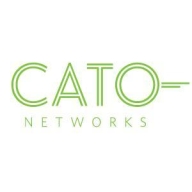


Find out what your peers are saying about Fortinet, Cisco, Cato Networks and others in Software Defined WAN (SD-WAN) Solutions.
| Product | Market Share (%) |
|---|---|
| Fortinet FortiGate | 18.7% |
| Cato SASE Cloud Platform | 7.8% |
| NFX Series Network Services Platform | 1.0% |
| Other | 72.5% |


| Company Size | Count |
|---|---|
| Small Business | 350 |
| Midsize Enterprise | 129 |
| Large Enterprise | 187 |
| Company Size | Count |
|---|---|
| Small Business | 14 |
| Midsize Enterprise | 7 |
| Large Enterprise | 9 |
Fortinet FortiGate excels in providing integrated VPN, firewalling, and Unified Threat Management (UTM) with centralized management and high availability. It supports remote access and comprehensive threat protection, making it a preferred choice for securing networks.
Fortinet FortiGate offers a robust security platform with features such as strong intrusion prevention, application control, and web filtering. Its integration with Active Directory and SD-WAN functionality provides scalable solutions for large networks. Users appreciate its ease of use through centralized management interfaces, ensuring robust security with flexible configurations. However, FortiGate could enhance its graphical interface and technical support responsiveness, address firmware bugs and costly licensing, improve logging, integrate better with third-party tools, and strengthen scalability and memory for log storage. Complexity in configuration and the need for intuitive features are noted challenges, and there's a demand for advanced security, zero-trust capabilities, and AI integration.
What are the key features of Fortinet FortiGate?Fortinet FortiGate is widely implemented across industries like education, finance, and government. Companies use it for firewall protection, VPN, and SD-WAN capabilities, ensuring secure perimeter and data center security. It facilitates remote access management and traffic routing optimization, offering reliable security and connectivity solutions.
Cato Networks is a leading SASE (Secure Access Service Edge) platform, combining SD-WAN and network security to obtain a cloud-native service. Cato Networks optimizes and secures application access for users and identities. The platform delivers a next-generation secure networking architecture that minimizes legacy IT infrastructures’ complexity, costs, and risks. The goal of Cato Suite is to connect any user to any application securely and optimally.
Cato Suite runs on a private global network of more than 65 PoPs (points of presence) connected via SLA-backed network providers. The service can connect branches, data centers, users, and clouds. Cato can be deployed in stages to augment legacy network services.
Cato Suite delivers end-to-end route optimization for WAN and cloud traffic. The architecture is self-healing, enabling a high service uptime.
Cato Features
Cato Cloud has a global backbone to deliver a reliable, global network. Here are some key SD-WAN features of Cato Cloud.
What challenges does Cato Network solve?
MPLS (multi-protocol label switching) networks are usually expensive and limited in their capacity. Cato simplifies migrating to a faster, higher-capacity internet and SASE cloud. Cato SD-WAN appliances enable customers to improve usable capacity and resiliency.
Customers who suffer from the challenge of high latency and network inconsistency can use Cato to deliver a consistent connection and user experience to access on-premises and cloud applications.
Cato’s complete network security stack connects all branch locations to the Cato cloud, therefore protecting all traffic, both internet-bound and WAN, with enterprise-grade, cloud-based security services. This capability avoids having to backhaul internet traffic to a data center or hub or having to implement stand-alone cloud security solutions.
Organizations using Cato notice an acceleration of cloud traffic. Cato achieves this by routing all traffic from the edges to the PoP closest to the data center. Because of the close distance between the two, the latency is near zero.
Reviews from Real Users
An IT manager/project coordinator at a healthcare company says that “[Cato is] a cloud-based solution that integrates well with everything. They are the classic SaaS solution.”
Yeong-Gi L., a network engineer at Snetsystems, notes that “The solution is very stable. The scalability is quite good. Technical support was always helpful and responsive. The integration capabilities are not a problem at all.”
"The most valuable feature is that it also works as a next-gen firewall because it has security features," says Lorenzo S., senior solutions consultant Lead at MDI.
The NFX Series Network Services Platform family is a universal CPE platform that provides secure SD-WAN and service delivery.
The NFX250 enables the creation of innovative services and automates services activation, with zero truck rolls. It hosts the vSRX Virtual Firewall to provision secure, ultra-fast custom service delivery on demand, including SD-WAN.
The open framework supports third-party VNFs to provide flexible branch deployment options.
Support for up to 8 VNFs with a 64-Gbps Packet Forwarding Engine and up to 20GbE WAN throughput.
Multiple WAN network interfaces including 10/100/1000BASE-X SFP, 1/10GbE SFP+, and ADSL2 and VDSL2 via SFP.
The NFX350 is a powerful universal CPE platform for large branch deployments, with flexible network interfaces, third-party VNF support, and automation to enable secure, scalable SD-WAN.
The open framework supports third-party VNFs to provide flexible branch deployment options.
Support for up to 12 VNFs with its 128 GB memory and 200 GB SSD storage.
High-performance, 7.5-Gbps IPsec throughput.
The NFX150 simplifies enterprise network connectivity and can also deliver a broad portfolio of managed services, including SD-WAN. It uses SRX Series software for security, multiple connection options (including 4G/LTE and ADSL2/VDSL2), and open, standards-based architecture.
The open framework supports third-party VNFs to provide flexible branch deployment options.
Support for up to 3 VNFs with its 32 GB DDR4 memory and 200 GB SSD storage.
Multiple WAN network interfaces including 1/10GbE SFP+, ADSL2, and VDSL2 via SFP, built-in LTE modem with support in North America, Europe, Asia Pacific, Australia, and New Zealand.
We monitor all Software Defined WAN (SD-WAN) Solutions reviews to prevent fraudulent reviews and keep review quality high. We do not post reviews by company employees or direct competitors. We validate each review for authenticity via cross-reference with LinkedIn, and personal follow-up with the reviewer when necessary.